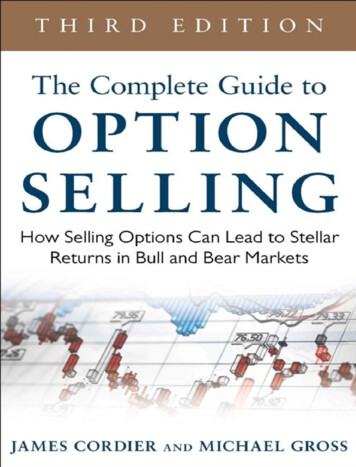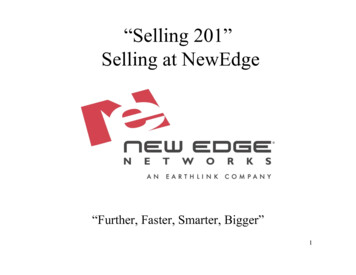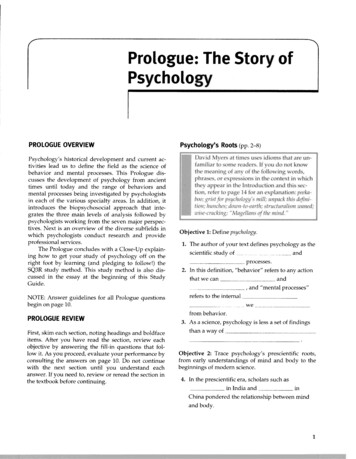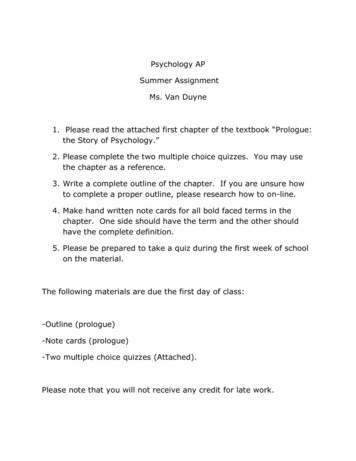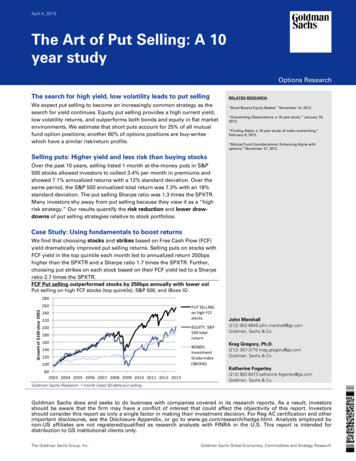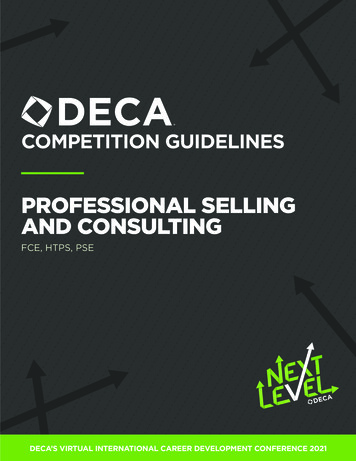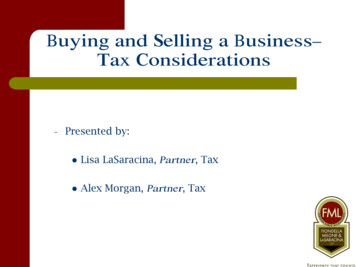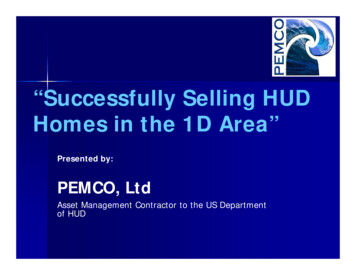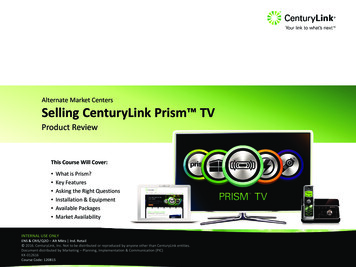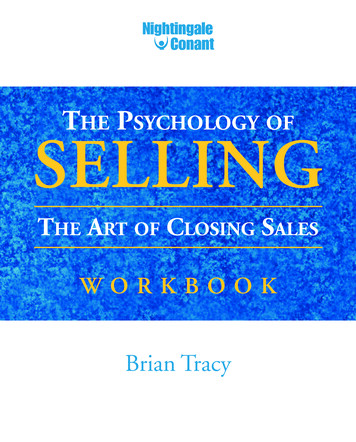
Transcription
THE PSYCHOLOGY OFSELLINGTHE ART OF CLOSING SALESWORKBOOKBrian Tracy
IMPORTANTTo begin—Please save this workbook to yourdesktop or in another location.2
ContentsHow You Can Benefit Most from This Program . . . . . . . . . . . . . . . . . . . . . . . . . .41. The Psychology of Selling . . . . . . . . . . . . . . . . . . . . . . . . . . . . . . . . . . . . . . . . . .52. Developing a Powerful Sales Personality . . . . . . . . . . . . . . . . . . . . . . . . . . . . .73. Why People Buy . . . . . . . . . . . . . . . . . . . . . . . . . . . . . . . . . . . . . . . . . . . . . . . . .94. Creative Selling . . . . . . . . . . . . . . . . . . . . . . . . . . . . . . . . . . . . . . . . . . . . . . . . .115. Approaching the Prospect . . . . . . . . . . . . . . . . . . . . . . . . . . . . . . . . . . . . . . . .136. The Sales Process . . . . . . . . . . . . . . . . . . . . . . . . . . . . . . . . . . . . . . . . . . . . . . .157. The Psychology of Closing . . . . . . . . . . . . . . . . . . . . . . . . . . . . . . . . . . . . . . . .178. When Objections Get in the Way . . . . . . . . . . . . . . . . . . . . . . . . . . . . . . . . . . .199. Winning Closing Techniques – I . . . . . . . . . . . . . . . . . . . . . . . . . . . . . . . . . . . .2110. Winning Closing Techniques – II . . . . . . . . . . . . . . . . . . . . . . . . . . . . . . . . . .2311. Managing Your Time Efficiently . . . . . . . . . . . . . . . . . . . . . . . . . . . . . . . . . .2512. Ten Keys to Success in Selling . . . . . . . . . . . . . . . . . . . . . . . . . . . . . . . . . . . .273
How You Can Benefit Most From This ProgramThe final value to you of The Psychology of Selling will depend on how many of its insights and guidelines you can, or choose to, adopt as routine ways of thinking and acting. You’ll be wise to listen toeach audio session several times. Don’t expect to get full value from these sessions if you hear themonly once. Even the most intelligent, thoughtful listener needs to hear sessions such as these severaltimes to be able to pick up, think over and internalize all the ideas discussed. Also, each repeated listening will spark for you additional ideas that apply to your current needs and goals.Make Concentrated Listening a HabitSet aside a short period each morning or evening, or both, when you can listen with full attention tothe sessions with which you are working. This does not in any way preclude casual listening – whileyou’re driving your car, dressing, eating or exercising, for example. It is simply a more concentratedform of listening.Jot Down Your IdeasWhenever you’re listening, keep pen and paper at hand, and be prepared to stop your audio player atany time. When you hear an idea or technique that particularly appeals to you, stop the audio. Thinkabout the idea. Think about it in connection with your situation, your work, your life-style. Thinkabout its value to you – how it could change and improve what you are doing. Think about how youcan apply it, visualize yourself doing so and making it pay off for you. Jot down some notes to remindyourself of your thinking and to help you take action during the days ahead. Then restart the audioAct on Your IdeasUntil intelligent thought is linked with appropriate action and follow-through, little or nothing is accomplished. So once you’ve grasped a particular idea or technique and how to apply it, act – put it towork in your career. The results may seem slow at first, but if you’re determined to stick with the program, you’ll soon discover that you’re closing more sales – and reaping the greater cash rewards thatcome to the top sales professional.Using This GuideHow can you get the most out of this writeable workbook? Research has shown that the more waysyou interact with learning material, the deeper your learning will be. Nightingale-Conant has createda cutting-edge learning system that involves listening to the audio, reading the ideas in the workbook,and writing your ideas and thoughts down. In fact, this workbook is designed so that you can fill inyour answers right inside this document.For Each Session, We Recommend the Following: Preview the section of the workbook that corresponds with the audio session,paying particular attention to the exercises. Listen to the audio session at least once. Read the text of the workbook.In addition to the exercises and questions, we’ve created an “ijournal” to make this an even moreinteractive experience for you. At the end of this guide, you can write down any additional thoughts,ideas, or insights to further personalize the material. Remember, the more you apply this information,the more you’ll get out of it.4
THE PSYCHOLOGYOFSELLINGSESSION ONEThe Psychology of SellingSELF-ASSESSMENT1. Am I proud of my profession?2. Am I in the top 20 percent of salespeople?3. Do I genuinely like myself?4. Is there any aspect of selling that makes me uncomfortable?5. Does my self-concept include a high level of income?6. Can I cope with the rejection that I will inevitably encounter in selling?SUMMARYThe most important thing we have to understand in the world of selling is that nothing happens untilthe sale takes place. The most successful organizations in the world have superb selling organizations.They rise or fall on the quality of their sales effort. We can be proud to be salespeople because it isupon our efforts that the whole economy floats. There is no limit to where we can go in this profession if we are properly trained and skilled in selling.In selling, the 80-20 rule, or the Pareto principle, prevails. According to the 80-20 rule, 80 percent ofsales are made by 20 percent of the salespeople. Once you get into the top 20 percent, you don’t haveto worry about money or employment again. Your job is to get into the top 20 percent and then intothe top 4 percent. In the top 4 percent, you become one of the highest paid people in the world. Thepurpose of The Psychology of Selling is to show you how to achieve that goal.The winning edge theory says that the difference between top performers and average or mediocreperformers is not a great one. It is always just a small difference: Top performers just do certain thingsa certain way a little bit better each day. If you develop that winning edge, there’s no reason why youcannot move rapidly into the top 4 percent.Selling is an inner game. That is, what is going on inside the mind of the salesperson makes all thedifference in his success. We know there is a direct relationship between a salesperson’s self-conceptand his sales performance and effectiveness. We feel uncomfortable if we don’t act in accordance withour self-concept. We will never earn much more or much less than our self-concept level of income.Our job is to raise this self-concept level of income.We always sell in a manner consistent with our self-concept. Some of us are uneasy about picking upthe phone and calling somebody. Some of us feel uncomfortable about closing. By becoming moreskilled, we feel more competent, raise our self-concept and become more successful.The core of self-concept is self-esteem. A person with high self-esteem likes himself. How much youlike yourself is the key determinant of your performance and your effectiveness in everything you do.There are two major obstacles in selling. The first obstacle is the customer’s fear of making a mistake.The second major obstacle in selling is the salesperson’s fear of rejection. Until a salesperson developsconfidence, a high self-concept and sufficient resilience to bounce back from inevitable rejection, hecannot sell successfully. All outstanding salespersons have reached the point where they no longerfear rejection.5
THE PSYCHOLOGYOFSELLINGSales are usually based on friendship. People will not buy from you until they are genuinely convincedthat you are their friend and are acting in their best interest. There is a direct relationship betweenyour level of self-esteem and how well you get along with different people. The best salespeople havea natural ability to make friends easily with perspective customers.A key element in selling is enthusiasm. A sale is a transfer of your enthusiasm about the product orservice into the mind and heart of the other person.The reason so many people fail in sales is that they do not stay with it long enough to get those firstfew winning experiences that raise their self-esteem and self-concept and set them off on a successfulcareer in selling. That’s why it’s so important that from the very beginning you say to yourself thatnothing is going to stop you until you are successful.SELF-HELP1. List five aspects of selling that you enjoy:2. List any areas of your self-concept that should be improved. How could you increase yourself-esteem?6
THE PSYCHOLOGYOFSELLINGiJOURNAL7
THE PSYCHOLOGYOFSELLINGSESSION TW0Developing a Powerful Sales PersonalitySELF-ASSESSMENT1. Do I have high levels of self-confidence, self-esteem, ambition and determinationto succeed?2. Am I goal oriented, with a plan to attain my goals?3. Do I understand the needs and care about the well-being of my customers?4. Am I willing to work hard, take responsibility for myself and pay the price for success?5. Do I believe strongly in my company and my product, and can I communicatemy enthusiasm to others?6. Is it easy for me to make friends out of strangers?SUMMARYA powerful sales personality is more important than product knowledge, selling skills or the product.Superior salespeople have 10 characteristics. The first is a high level of self-confidence andself-esteem. Number two: The high performing salesperson accepts full responsibility for his resultsand looks upon himself as self-employed. Number three: The top salesperson has above averageambitions and desire to sell. Number four includes high levels of empathy and concern for customers.Number five: The successful salesperson is intensely goal oriented. Six: He has above averagewillpower. Seven: He has determination and willing- ness to work hard. Eight: He believes in himself,his product and his company. The ninth characteristic is that the top selling salesperson is alwaysabsolutely honest with himself and with other people. Finally, the top salesperson has the abilityto turn strangers into friends wherever he goes.How do we fulfill this psychological profile and become a successful salesperson? First, choose theright product. Some people are capable of selling tangible products, and some people are capableof selling intangible products. Next, you must believe absolutely in your product. Third, you mustbe able to transfer your enthusiasm to the mind of your customer.How do we become intensely goal oriented? Goals must be realistic and challenging. Define yourgoals in terms of the activities that you will have to engage in to achieve your desired income level.The activities include the number of calls, follow-ups, deliveries, presentations, etc. When you seta goal, you program it into the subconscious, which has the power to move you rapidly toward yourgoal. Also set personal and family goals. Make a detailed list of all the things you want to do thatdepend on being successful in selling.When you feel good about yourself, things seem to go smoothly. Visualization is the very best way toput yourself in a positive frame of mind. See yourself as the best in your field. See yourself as the topmoney earner.Confidently expect to succeed every minute of every day. Professional salespeople are low-keyed, calmand relaxed, and they have absolute confidence.Read about your profession for 30 minutes a day. If you will read for 30 minutes every morning,within six or 12 months you will have read 10 to 20 of the very best sales books that have ever beenwritten. Listen to the CDs. Turn your car into a university on wheels. If you’re continually feeding yourmind with cassettes and books about sales, motivation, inspiration, time management and personaldevelopment, you’re going to move ahead faster than anybody else in your profession.8
THE PSYCHOLOGYOFSELLINGAfter every call, ask yourself what you did right. Think about how you would handle it differently nexttime. If we review what we did right and then think about how we would do it better in the future,that is what we’ll do automatically when we go into the next sales situation.Resolve to pay the price to succeed. For everything we want in life, there is a price. Success comesonly after you’ve paid the price, never before.SELF-HELPThe only way to become goal-oriented is to plan your working day and week carefully. Yourgoal must be realistic but challenging. They must be defined in terms of activities necessaryto achieve those goals. Fill out the plan below as an aid to fulfilling your goals.1. Annual Income Goal 2. Annual Sales Volume Required 3. Monthly Income Goal 4. Monthly Sales Volume Required 5. Weekly Income Goal 6. Weekly Sales Volume Required 7. Daily Income Goal 8. Daily Sales Volume Required 9. Number of Calls Daily9
THE PSYCHOLOGYOFSELLINGiJOURNAL10
THE PSYCHOLOGYOFSELLINGSESSION THREEWhy People BuySELF-ASSESSMENT1. Do I understand the basic reasons why people buy any product or service?2. Do I know how to uncover the basic needs of a prospective customer?3. Do I know my product well enough to understand the needs it will satisfy?4. Do I understand that quality alone is not enough to motivate a customer to buy?5. As a closing technique, do I determine and focus on the prospect’s one main reasonfor buying the product?SUMMARYIt’s important to understand that people buy for their reasons, not ours. Every buying decision is anattempt to be better off as a result of having made that decision. The individual who’s making a buying decision has three choices: He can buy from you, from someone else, or from no one.All professional selling begins with need analysis. And you’re not in a position to sell until you understand what need of the prospect your product or service can satisfy and then structure your presentation so it satisfies that need. Your job is to get the person to the point where he is completely focusedon how he will gain by using your product, rather than how much he might lose by committing himself to it.All buying decisions are emotional. If we say we’re going to do something for a logical reason, thatmeans we have more emotion invested in that reason than any other. Whenever a person says hewould like to think about it, he is saying that you have not aroused his desire to own or enjoy the benefits of your product.The basic rule of selling is that people do not buy products; they buy benefits. And our job in the salesconversation is to find out what benefits this person would be willing to pay for. You uncover needs byquestioning skillfully and listening carefully. If you let people talk for a time, they will tell you theirbasic need or concern with regard to your product.People naturally resist new things. Instead of presenting a product as something new, present it as animprovement. Customers want the simple truth about a product or service. They want honest information about how it can help them improve their lives and their businesses. They resent and resisthigh pressure.Quality is never the primary reason for buying anything. Quality is always based on logic, and peoplebuy emotionally. The issue of quality should arise only when you are comparing your product at a certain price with another product at a certain price and there are very definite reasons why the personshould be concerned about quality.In the prospect’s mind, the caliber of the sales presentation, the materials used in the presentation,and the appearance of the salesperson reflect the quality of the product itself. Moreover, if a salesperson is well groomed and dressed and his presentation is professional, the prospect assumes that thecompany is a high-quality company.11
THE PSYCHOLOGYOFSELLINGAs long as you are focusing all your attention on the customer and what he or she wants and needs,you’re selling professionally. In every sales conversation there is a key benefit — the major benefit thatwould cause the person to buy the product. Also, there is a key issue — the major objection that wouldhold the person back from buying the product. In the sales interview, your job is to uncover the keybenefit and then uncover the key issue.The hot button is considered by many to be the most powerful of all closes. The success of the hotbutton close depends upon the ability of the salesperson to discover the most important reason for thecustomer buying the product, and then repeating it over and over. Concentrate on selling that onemain point.SELF-HELP1. Explain how you would conduct a needs analysis to connect the benefits of your productwith a prospect’s need.2. List several ways in which you can improve your personal appearance.3. Write one question you would use during the hot-button close to uncover the prospect’smajor reason for not buying your product.12
THE PSYCHOLOGYOFSELLINGiJOURNAL13
THE PSYCHOLOGYOFSELLINGSESSION FOURCreative SellingSELF-ASSESSMENT1. Do I use my creativity to find prospects and to devise more effective selling skills?2. Have I identified my best prospective customers and concentrated my efforts on them?3. Do I know my competition and the benefits their products offer?4. What advantage do I have over my competition?5. Who are my noncustomers, who are not even in the market? Why don’t they buy?6. Have I used testimonial letters from satisfied customers as a selling tool?SUMMARYAll top salespeople are creative. That creativity is a matter of self-concept. Many of us think that we’renot particularly creative. If we believe that we’re not creative, we won’t be. If we believe we are, wewill continually come up with creative solutions. Creativity is stimulated by focused questions, bypressing problems, and by deeply desired goals.Creative selling begins with thorough knowledge of your product or service. The better you knowyour product or service, the more thoroughly you master the detail of it, the more creative you arein selling it.The successful salesperson identifies his best possible customer market and then concentrates on itsingle- mindedly. One of the biggest mistakes salespeople make is looking upon everybody as aprospect of equal value, when in some cases one prospect may be worth a hundred times the valueof another. It’s vital that we identify our best prospects. Ask yourself questions such as the following:Who exactly is my customer? Who buys my product or service right now? Who might be buying it inthe future? Who bought it in the past? Why does he buy? Where do I have an advantage over my competitors? What do I have to offer that nobody else has? Your key job is to identify that unique sellingfeature, that competitive advantage that sets you head and shoulders above anybody else, and buildyour sales presentation around that.Who are your noncustomers? They are people who don’t buy from you or from your competition —the ones who are not in the market at all. The people who are not buying your product or anybodyelse’s are the greatest single source of new customers.Many people will not buy anything until they have a recommendation from somebody they respect.That’s why testimonial letters are so valuable. A testimonial is worth an hour of your trying toconvince the customer how good the product is.The 20-idea method is a creative way to double your income. Take your key problem and write it, atthe top of a sheet of paper, in the form of a question. For example: How could I double my sales thisyear? Or: How can I increase my ratio of closes to calls? Then write out 20 answers to the question. Ifyou do this for two or three days, you will have so many ideas and so many new ways to develop morebusiness that you will not have enough time in the day to do it all. If you use this method, you willbecome one of the most creative salespeople and, by extension, one of the most highly paid salespeople in your profession.14
THE PSYCHOLOGYOFSELLINGSELF-HELP1. What are the five most attractive features of your product? List then in order of importance.2. What needs of your prospective customers do these product features satisfy?What benefits do they offer?3. List five reasons why your customer should purchase the product or servicefrom your company.15
THE PSYCHOLOGYOFSELLINGiJOURNAL16
THE PSYCHOLOGYOFSELLINGSESSION FIVEApproaching the ProspectSELF-ASSESSMENT1. Do I carefully plan my approach to a prospect to get his complete attention quickly?2. Am I careful to qualify the buyer I’m talking to by making sure he is the right personto make a buying decision about my product?3. Do I have difficulty getting appointments on the telephone?4. Do my attitude and appearance create an air of calmness and confidence?5. Am I always neat and well groomed when I meet with a customer?6. Do I use body language in a manner that will in-crease customer confidence in meand my product?SUMMARYYour first contact with the prospect will begin the process that will or will not conclude with a sale.Therefore, every word of your approach, or introduction, must be planned in advance. Your approachmust break the preoccupation of the prospect. Unless you break that preoccupation, you never get tofirst base in making a presentation. You have only 30 seconds at the beginning of the approach to getthe person’s complete attention. So your opening question has to be planned word for word, memorized and practiced over and over.Before the prospect will relax and listen to you, he wants to be sure of five things. He wants to be surethat you have something important to communicate, that you’re talking to the right buyer, that yourvisit will be short, that he will be placed under no obligation and that you will not use high pressure.When making appointments by telephone, there are several factors to keep in mind. Ask a well-structured, imaginative question related to the benefits of your product. Be polite, respectful and firm – butdon’t argue. Assure the prospect that you will not use high-pressure tactics – keep repeating that hewill be the judge of your product’s value to him. Refuse to discuss your proposition over the telephoneor to mail information. Offer to drop the information off at his office. Nail down a date and time foran appointment by being aggressive and insistent but polite. Smile into the phone and relax. Thankthe prospect for his time, and repeat the date and time of the appointment.Immediately prior to the sales call, pause before you go in and get a clear mental picture of yourselfrelaxed, calm, positive, smiling and in complete control of the interview.Never make your presentation standing up. If you do, you run the risk of devaluing your product.Nobody considers a product of any value if you’re willing to sell it standing up, unless you’re sellingin a showroom.The suggested influence of a calm, confident, relaxed salesperson is very powerful. The mostprofessional salespeople have a soothing effect on us. They exude confidence in themselves andin their product. Therefore, we feel confident about listening to them.Three powerful suggested influences are your appearance, your voice and your attitude. If yourappearance is professional and your voice is loud and clear, as opposed to low or shy or retiring,and your attitude is calm and positive, you are creating a selling atmosphere.17
THE PSYCHOLOGYOFSELLINGYour product should always be presented in the best possible light. People are influenced by the suggested impact of a product that is clean, neat, efficient and attractive. Your surroundings, especiallywhen customers come into your office, should be neat and clean and convey success and prosperity.Body language is important because 80 to 90 percent of all our communication is nonverbal. Alwaysstand and sit erect. Never fold your arms when you’re talking to people because it means you’reclosing them out. Crossed legs (over the knee) means you’re holding back information. Your bestposition is leaning slightly forward. Attentively watch the prospect, listening carefully to what he issaying, and nod and smile.Always try to minimize the noise and interruptions in the selling environment.Always be extremely polite and courteous. Be considerate with prospects and spouses, partners,employees and receptionists. One of the basic rules of selling is to treat everybody like a million-dollarprospect or client, and you’ll never go wrong.SELF-HELP1. Write three questions you ask to get the prospect’s attention for your product.2. List five factors that must be apparent to a prospect before he will listen to your presentation.3. List several ways in which you could improve your voice, appearance and attitude to create abetter selling environment.18
THE PSYCHOLOGYOFSELLINGiJOURNAL19
THE PSYCHOLOGYOFSELLINGSESSION SIXThe Sales ProcessSELF-ASSESSMENT1. Do I use different presentations for each buyer personality type?2. What is my dominant personality style?3. Do I talk to customers in terms of their interests and needs or mine?4. Is my presentation carefully planned in a step-by- step, logical sequence?5. During my presentation, do I keep my prospect involved so he stays attentive?6. Am I using enough visual aids during my presentation?SUMMARYThe approach close is a strong close you can use to avoid the prospect saying he’ll think it over andassure a decision after you’ve made your presentation. You deflate buyer resistance by saying, “I’m notgoing to try to sell you anything right now. All I want to do is show you some of the reasons why somany others have bought this product. All I ask is that you look at what I have to show you openlyand honestly and determine whether or not it applies to your situation. And tell me at the end of thispresentation whether or not, yes or no, this is applicable to you.”The second close you can use in the approach is the demonstration close. This close starts with astrong question aimed at the chief result or benefit that the customer or prospect would enjoy, shouldhe buy your product.There are several buyer personality types. The first of these is the apathetic type — the negative, cynical person who’s never going to buy anything. On the other end of the scale are the self-actualizingbuyers, who know exactly what they want and exactly what they’re willing to pay, and if you have it,they’ll take it right now. Analytical buyers care only about the details. They want to know about everysingle nut and bolt. The primary concern of emotional, relationship-oriented buyers is other people’sresponses to the product. The entrepreneurial, practical, task-focused buyer is very direct and wantspractical results. You must determine what type of person you’re talking to and then structure yourpresentation and your answers to satisfy his needs.The first thing we do when we phone customers or see them in person is ask them an opening question. The answer to that tells us at the beginning whether or not they’re in the market for our product.The purpose of the presentation is to further qualify the prospect and to discover the key reasons whyhe might buy.The planned presentation is 20 times more powerful than the random presentation. All top moneyearners use a planned presentation. After your opening question, you go through a logical, step-bystep process to show the prospect what your product does and what it can do for him.Among the most important selling skills are good listening skills. There are five keys to effective listening: (1) Face the prospect, lean forward and listen attentively without interruption. (2) Pause beforereplying or continuing, and then answer thoughtfully. (3) Question for clarification — say, “How doyou mean?” (4) Relax, take it easy, stay calm, and focus your attention on how you can help thisprospect get something he or she needs. (5) Use close-ended questions to help the prospect give a firmanswer.20
THE PSYCHOLOGYOFSELLINGBegin trial closing early in the presentation. A trial-close question you can ask is, “Did this make senseto you?” or, “Is this what you had in mind?” In the power-of- suggestion close, you use vivid, emotional, imaginative images to influence the buying decision. Create vivid, colorful pictures, as thoughthe person were already using the product.SELF-HELP1. List some of your customers who fall into each of the buying personality types: apathetic,self-actualizing, analytical, emotional, and practical.2. List three ways in which you could improve your listening skills.3. Write two open-ended and two close-ended questions you could ask a prospect abouthis needs in relationship to your product.21
THE PSYCHOLOGYOFSELLINGiJOURNAL22
THE PSYCHOLOGYOFSELLINGSESSION SEVENThe Psychology of ClosingSELF-ASSESSMENT1. Do I recognize and take advantage of signals that indicate the prospect is ready to buy?2. Do I plan detailed, word-for-word closings in advance of my sales presentation?3. Do I understand how emotional and stressful a buying decision can be?4. Do I argue with prospects and tell them why they are wrong?5. Do I make promises about the product that I cannot keep or oversell by sayingit will do something it will not do?6. Do I express my opinions about religion or politics or discuss personal problemswith customers?SUMMARYClosing is the most painful part of a sales presentation. Closing is the part that we, as salespeople,hate, and it is also the part that the customer hates. We have an obligation to our client to go smoothlythrough the close, so it is as painless as possible.Plan your close in detail, and then build your sales presentation on top of it. There are severalmajor requirements for closing. You must be positive, enthusiastic, and eager to close the sale. Thecustomer’s requirements must be clear to you. The customer must understand what you are offeringand must understand
selling presentation is the pressure of silence after the closing question. We must recognize common buying signals. The customer may begin talking faster or brighten up or ask about price or delivery. Any change in attitude, posture, voice o
